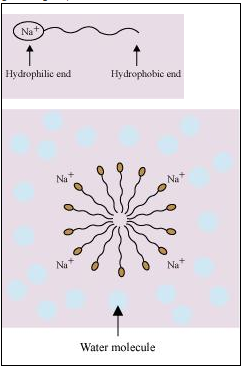Class 12 Chemistry - Chapter Surface Chemistry NCERT Solutions | What are micelles? Give an example of a
What are micelles? Give an example of a micellers system.
Micelles formation is done by substances soaps and detergents when dissolved in water.The Molecules of such substances contain a hydrophobic and a hydrophilic part. when present in water, these substances arrange themselves in spherical structure in such a manner that their hydrophobic parts are present towards the centre, while the hydrophilic parts are pointing towards outside (as shown in the given figure). This is known as micelles formation.

More Questions From Class 12 Chemistry - Chapter Surface Chemistry
- Q:-
Explain what is observed
(i) When a beam of light is passed through a colloidal sol.
(ii) An electrolyte, NaCl is added to hydrated ferric oxide sol.
(iii) Electric current is passed through a colloidal sol?
- Q:-
Why is adsorption always exothermic?
- Q:-
What do you mean by activity and selectivity of catalysts?
- Q:-
What modification can you suggest in the Hardy-Schulze law?
- Q:-
Explain the following terms:
(i) Electrophoresis
(ii) Coagulation
(iii) Dialysis
(iv) Tyndall effect.
- Q:-
What is an adsorption isotherm? Describe Freundlich adsorption isotherm.
- Q:-
Explain the terms with suitable examples:
(i) Alcosol
(ii) Aerosol
(iii) Hydrosol
- Q:-
How are colloids classified on the basis of
(i) Physical states of components
(ii) Nature of dispersion medium and
(iii) Interaction between dispersed phase and dispersion medium?
- Q:-
Discuss the effect of pressure and temperature on the adsorption of gases on solids.
- Q:-
Why does physisorption decrease with the increase of temperature
Popular Questions of Class 12 Chemistry
- Q:-
For the reaction R → P, the concentration of a reactant changes from 0.03 M to 0.02 M in 25 minutes. Calculate the average rate of reaction using units of time both in minutes and seconds.
- Q:-
Write the formulas for the following coordination compounds:
(i) Tetraamminediaquacobalt (III) chloride
(ii) Potassium tetracyanonickelate(II)
(iii) Tris(ethane-1,2-diamine) chromium(III) chloride
(iv) Amminebromidochloridonitrito-N-platinate(II)
(v) Dichloridobis(ethane-1,2-diamine)platinum(IV) nitrate
(vi) Iron(III) hexacyanoferrate(II)
- Q:-
(i) Write structures of different isomeric amines corresponding to the molecular formula, C4H11N
(ii) Write IUPAC names of all the isomers.
(iii) What type of isomerism is exhibited by different pairs of amines?
- Q:-
Why are solids rigid?
- Q:-
Write the structures of the following compounds.
(i) α-Methoxypropionaldehyde
(ii) 3-Hydroxybutanal
(iii) 2-Hydroxycyclopentane carbaldehyde
(iv) 4-Oxopentanal
(v) Di-sec-butyl ketone
(vi) 4-Fluoroacetophenone
- Q:-
Which of the ores mentioned in Table 6.1 can be concentrated by magnetic separation method?
- Q:-
Why are pentahalides more covalent than trihalides?
- Q:-
Silver atom has completely filled d orbitals (4d10) in its ground state. How can you say that it is a transition element?
- Q:-
Glucose or sucrose are soluble in water but cyclohexane or benzene (simple six membered ring compounds) are insoluble in water. Explain.
- Q:-
Write structures of the following compounds:
(i) 2-Chloro-3-methylpentane
(ii) 1-Chloro-4-ethylcyclohexane
(iii) 4-tert. Butyl-3-iodoheptane
(iv) 1,4-Dibromobut-2-ene
(v) 1-Bromo-4-sec. butyl-2-methylbenzene
Recently Viewed Questions of Class 12 Chemistry
- Q:-
Explain the bonding in coordination compounds in terms of Werner’s postulates.
- Q:-
Show how are the following alcohols prepared by the reaction of a suitable
Grignard reagent on methanal?
(i)

(ii)

- Q:-
Write two main functions of carbohydrates in plants.
- Q:-
Write the formulas for the following coordination compounds:
(i) Tetraamminediaquacobalt (III) chloride
(ii) Potassium tetracyanonickelate(II)
(iii) Tris(ethane-1,2-diamine) chromium(III) chloride
(iv) Amminebromidochloridonitrito-N-platinate(II)
(v) Dichloridobis(ethane-1,2-diamine)platinum(IV) nitrate
(vi) Iron(III) hexacyanoferrate(II)
- Q:-
During nuclear explosion, one of the products is 90Sr with half-life of 28.1 years. If 1μg of 90Sr was absorbed in the bones of a newly born baby instead of calcium, how much of it will remain after 10 years and 60 years if it is not lost metabolically.
- Q:-
Describe the preparation of potassium permanganate. How does the acidifiedpermanganate solution react with
(i) iron
(II) ions
(ii) SO2 and
(iii) oxalic acid?
Write the ionic equations for the reactions.
- Q:-
What are the common types of secondary structure of proteins?
- Q:-
Differentiate between globular and fibrous proteins.
- Q:-
An antifreeze solution is prepared from 222.6 g of ethylene glycol (C2H6O2) and 200 g of water. Calculate the molality of the solution. If the density of the solution is 1.072 g mL-1, then what shall be the molarity of the solution?
- Q:-
Explain how vacancies are introduced in an ionic solid when a cation of higher valence is added as an impurity in it.
2 Comment(s) on this Question
the detergent in water
Example sir..
- All Chapters Of Class 12 Chemistry
- All Subjects Of Class 12
